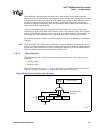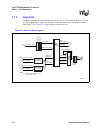
Hardware Reference Manual 237
Intel
®
IXP2800 Network Processor
SHaC — Unit Expansion
7.1.3.1 Hashing Operation
Up to three hash indexes (see Example 33) can be created by using one Microengine instruction.
A Microengine initiates a hash operation by writing a contiguous set of SRAM Transfer registers
and then executing the hash instruction. The SRAM Transfer registers can be specified as either
Context-Relative or Indirect; Indirect allows any of the SRAM Transfer registers to be used. Two
SRAM Transfer registers are required to create hash indexes for 48-bit and 64-bit, and four SRAM
Transfer registers to create 128-bit hash indexes, as shown in Table 82. In the case of the 48-bit
hash, the Hash Unit ignores the upper two bytes of the second Transfer register.
Example 33. Microengine Hash Instructions
hash1_48[$xfer], optional_token
hash2_48[$xfer], optional_token
hash3_48[$xfer], optional_token
hash1_64[$xfer], optional_token
hash2_64[$xfer], optional_token
hash3_64[$xfer], optional_token
hash1_128[$xfer], optional_token
hash2_128[$xfer], optional_token
hash3_128[$xfer], optional_token
Where:
$xfer
The beginning of a contiguous set of registers that supply the data used
to create the hash input and receive the hash index upon completion of
the hash operation.
optional_token sig_done, ctx_swap, defer [1]
Table 82. S_Transfer Registers Hash Operands (Sheet 1 of 2)
Register Address
48-Bit Hash Operations
Don't care hash 3[47:32] $xfer n+5
hash 3 [31:0] $xfer n+4
Don't care hash 2[47:32] $xfer n+3
hash 2 [31:0] $xfer n+2
Don't care hash 1[47:32] $xfer n+1
hash 1 [31:0] $xfer n
64-Bit Hash Operations
hash 3 [63:32] $xfer n+5
hash 3 [31:0] $xfer n+4
hash 2 [63:32] $xfer n+3
hash 2 [31:0] $xfer n+2
hash 1 [63:32] $xfer n+1
hash 1 [31:0] $xfer n


















